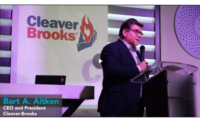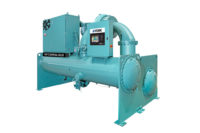ORLANDO, Fla. — Johnson Controls is reaching advanced levels of efficiency at even higher capacities with the launch of its expanded York® YZ Magnetic Bearing Centrifugal Chiller platform in North America and Latin America markets. Extending the use of magnetic bearings up to 2,020 tons gives more customers the opportunity to experience reduced driveline maintenance and lower operating costs.
This expansion in capacity builds on the award-winning YORK® YZ chiller that is optimized around R-1233zd(E) and utilizes an inherent series counterflow design with patented heat exchangers. The extended platform, up to 2,020 tons, is optimized around the environmentally friendly, low-GWP refrigerant, providing a future-focused solution today. The YZ chiller design tackles real-world energy challenges with the largest operating map in the industry to support the most challenging climates – including the Middle East where the single compressor YZ chiller recently launched.
“With energy efficiency driving customer decisions, we are pleased to offer the extended capacity York YZ chiller to deliver ultimate performance while dramatically reducing cost of ownership,” said Laura Wand, vice president and general manager, applied equipment, Johnson Controls. “These higher-tonnage systems support the same real-world operating conditions customers have come to expect from YORK, while delivering lower maintenance costs with the use of magnetic bearing technology.”
The advanced, aerodynamic design includes two, single-stage compressors that are paired in a series counterflow arrangement, reducing the lift on each compressor to improve overall full-load and off-design performance. The dual compressor design allows for each compressor to run individually, providing redundancy and improved off-design performance at lower loads. The design also increases turn down capabilities at low loads by continuing to provide cooling on one circuit in the unlikely event of a failure or an unplanned shutdown. For more information, visit www.york.com/next.
To see more Engineered Systems videos, click here.




